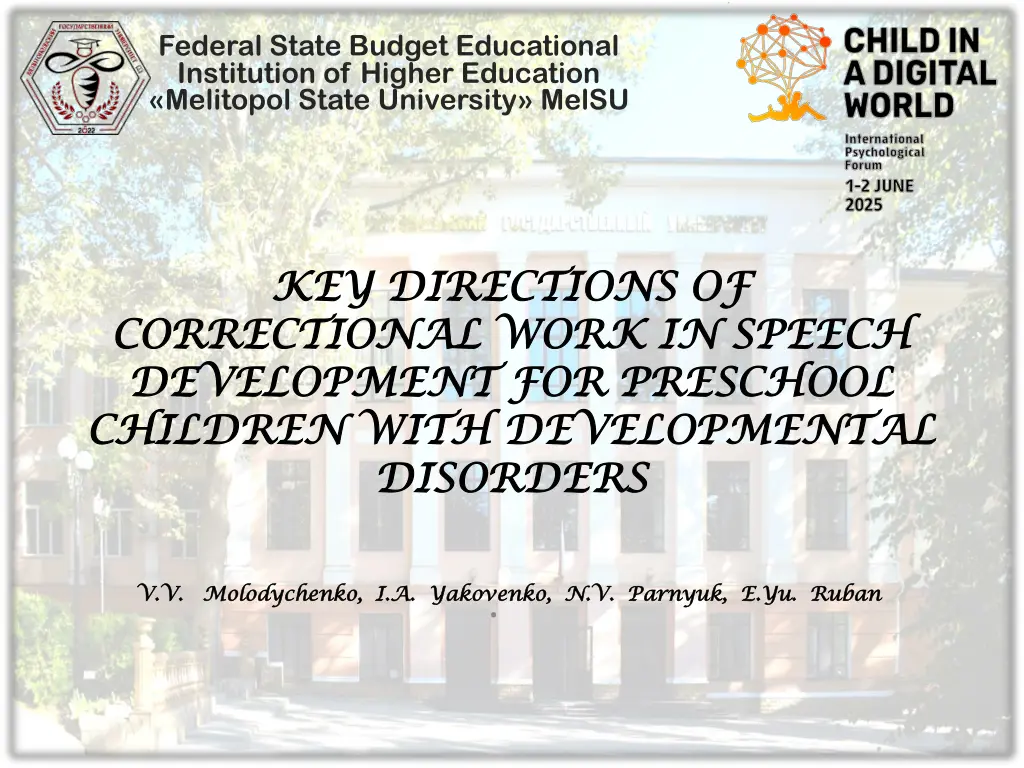
Key Directions of Correctional Work in Speech Development for Preschool Children with Developmental Disorders
Explore the key directions of corrective work for non-speaking preschool children with developmental disorders, focusing on optimizing speech initiation timing. This study delves into diagnostic results and methods used to assess children's speech, emotional, cognitive, and physical development, providing insights into the challenges faced and potential interventions for this specific group.
Download Presentation

Please find below an Image/Link to download the presentation.
The content on the website is provided AS IS for your information and personal use only. It may not be sold, licensed, or shared on other websites without obtaining consent from the author. If you encounter any issues during the download, it is possible that the publisher has removed the file from their server.
You are allowed to download the files provided on this website for personal or commercial use, subject to the condition that they are used lawfully. All files are the property of their respective owners.
The content on the website is provided AS IS for your information and personal use only. It may not be sold, licensed, or shared on other websites without obtaining consent from the author.
E N D
Presentation Transcript
Federal State Budget Educational Institution of Higher Education Melitopol State University MelSU KEY DIRECTIONS OF KEY DIRECTIONS OF CORRECTIONAL WORK IN SPEECH CORRECTIONAL WORK IN SPEECH DEVELOPMENT FOR PRESCHOOL DEVELOPMENT FOR PRESCHOOL CHILDREN WITH DEVELOPMENTAL CHILDREN WITH DEVELOPMENTAL DISORDERS DISORDERS V.V. V.V. Molodychenko, I.A. Molodychenko, I.A. Yakovenko, N.V. Parnyuk, E.Yu. Ruban Yakovenko, N.V. Parnyuk, E.Yu. Ruban .
Relevance. Due to the increased demand for consultative and corrective parents raising children of early and younger preschool age, a diagnosis of children with speech initiation issues was conducted as part of the grant from Foundation titled Principles and Approaches to Speech Initiation among Developmental Disorders Modeling Methods (No. 25-28-00391). Objective of the study. To identify and characterize the key directions of corrective work with non-speaking preschool children with developmental disorders to optimize the timing of speech initiation. assistance for the Russian Science Children through with Play
Sample. The study was conducted in the territories of Zaporizhzhia and Kherson regions of the Russian Federation. The experimental sample included 80 children aged 2 to 4 years. Methods. The main methods of the study included child development diagnostics (speech development, emotional-volitional physical development, cognitive sphere) and statistical data processing. sphere,
Results. As a result of the diagnostic work, it was found that 52% of non-speaking or minimally speaking children had insufficient mobility of the articulatory apparatus, slight delays in physical indicators, but relatively high levels of memory, concentration; 20% of diagnosed children did not have an adequate development for their age due to parental overprotection, prohibitions on active play, and fears from older siblings about overloading the child physically; 12% of the tested children had congenital developmental (neurological disorders); exhibited underdeveloped fine motor skills and coordination, as well as difficulties with static and dynamic articulatory exercises. attention, and task level of speech disorders children 16% of
Diagnostic results for non-speaking children (2-4 years old) Zaporozhye and Kherson regions Indicators Statistical data They had insufficient mobility of the articulatory apparatus, a slight lag in physical performance, but, at the same time, fairly high rates of memory development, attention and concentration on tasks. 52% They did not have a sufficient level of speech development by age due to the overprotection of parents, prohibitions on active games and the fear of elders to physically overload the child. 20% 12% They had congenital developmental disorders (neurological disorders) 16% Fine motor skills and coordination were insufficiently developed, and difficulties in static and dynamic articulatory exercises were also demonstrated..
We would like to pay special attention to the following indicators of practice, which directly affect the launch of speech. Note that the basis of praxis is perception and sensory integration. According to T.G. Wiesel's definition, starting from early childhood (from the age of two), we can talk about the formation of primary praxis. Thus, scientists have proved on the basis of practical research that a child's finger (manual) praxis can be evaluated from the age of two and a half; oral praxis from the age of three; from four articulatory ones. During diagnostic work with non-speaking children, the following indicators of the child's normal practice were taken as a sample.
The child's praxis indicators are normal (according to T.G. Wiesel) Praxis indicators Age of children Can run; walk backwards; go down and up stairs Uses a spoon, holds the cup correctly, and drinks on his own. Can jump from height, holding feet together Does not examine objects primarily by taking them in his mouth A story-based role-playing game is being formed Can build up to 5 cubes. Knows how to select shapes on a Seguin board Can partially dress and undress Draws vertical and horizontal lines Can ride a tricycle Can partially dress up, fasten large buttons Uses a fork Can draw a cross, a circle, wavy lines, straight lines according to the pattern. 2 years old 2,5 years old 3 years old 4 years old 4,5 years old Determines which boy was touched by an adult Performs an assignment according to the simple instructions of an adult Maintains balance for 5 seconds on one leg Knows how to invent a rhythmic line based on a pattern. Can draw yodino from basic details Can put together puzzles from 15-20 pieces. Knows how to cut with scissors, glue A certain dominant hand, eye when performing tasks Can draw geometric shapes Can slice vegetables and fruits, spread bread. 5 years old 5,5 years old 6 years old
Conclusions. developmental initiation, consultative assistance was provided to parents: all children individual articulatory and massage complex; attention was given to the child s physical development according to age (spatial praxis and gnosis); imitation games and object play aimed at sound imitation were prescribed; significant emphasis was placed on developing fine motor skills and finger games. Considering indicators the lagging speech affecting were assigned an
The study was conducted within the framework of a grant from the Russian Science Foundation Principles and approaches of speech initiation among children with developmental disabilities through game modeling methods (No. 25-28-00391) dated 12/28/2024.






















